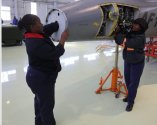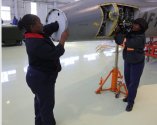Semi-Lobster
Junior Member
Very good summary thanks. I think this is an example of a small scale order that might be getting outside attention in Beijing this would be a significant contract for a country that's traditionally buys Western aircraft and the information I have is that it remains a very solid contender so we will see.
As for the JL-9 - if I'm not mistaken the back end of that aircraft is essentially a late j7 so a fairly tried and tested aircraft that they have added quite a bit of modern avionics and systems to, if I was negotiating for the Uruguayan government I would be asking about a small batch of JL-9s and an additional batch of low time refurbished J-7G's and just see what kind of offer they could come up with
Yes, trainers just don't get as much of the spotlight as fighters do, even if they are for light attack and fighter roles. There weren't even any trainers present at the recent 100th Anniversary of the CCP, perhaps we will learn more at this years Zhuhai Air Show.
The only export sale of the L-15 as mentioned before, was to Zambia, at $100 million dollars for 6 non-afterburning AI-222-25 aircraft, with training simulators and weapons. This will likely be a similar price for Uruguay who also would be starting from scratch when it comes to existing training material and Chinese weapon systems. As I mentioned earlier as well there are rumours of a planned follow up order from back in 2017 for 12 more L-15Bs but no photos or information on any progress have come out about those in years so I would be ready to just dismiss them at this point. The big issue for what is taking so long could also be the engines.
The L-15 still relies completely on imports from the Ukraine for small turbofan engines. Just earlier this year, China spent $800 million USD to purchase 400 AI-322 non-afterburning turbofan engines from Motor Sich in the Ukraine (The AI-322 is a slightly more specialized variant of the AI-222-25, specifically for the L-15). China did NOT buy any AI-322F engines though, and those are the afterburning variant of the engine that would allow the L-15 to reach supersonic speeds. All of this comes on top of the continued failure of the WS-17 Minshan project, wish has not shown any signs of progress since it was revealed all the way back in 2012. The biggest example of the WS-17's failure is that the Guizhou Soar Dragon WZ-7 high altitude drone was initially going to have the WS-17 but in the end the production model is instead equipped with the ancient WP-13 (a license built Tumansky R-13 turbojet). Since Uruguay is specifically looking for a supersonic aircraft, this could be the source of at least some of the problems.
As for the JL-9, I'm not sure why it's not being offered since it seems to check off more of the boxes Uruguay needs than the L-15A, but as mentioned earlier, it really is just a very, very modern J-7 and like the J-7, relies on an old-fashioned WP-13 turbojet and old Cold War era mechanical flight control systems and this could be why it is not being offered for export. I have never heard of China selling former PLAAF aircraft to another country, all Chinese export aircraft have always been built solely for export, I don't think selling off retired former PLAAF aircraft is something China really does.




